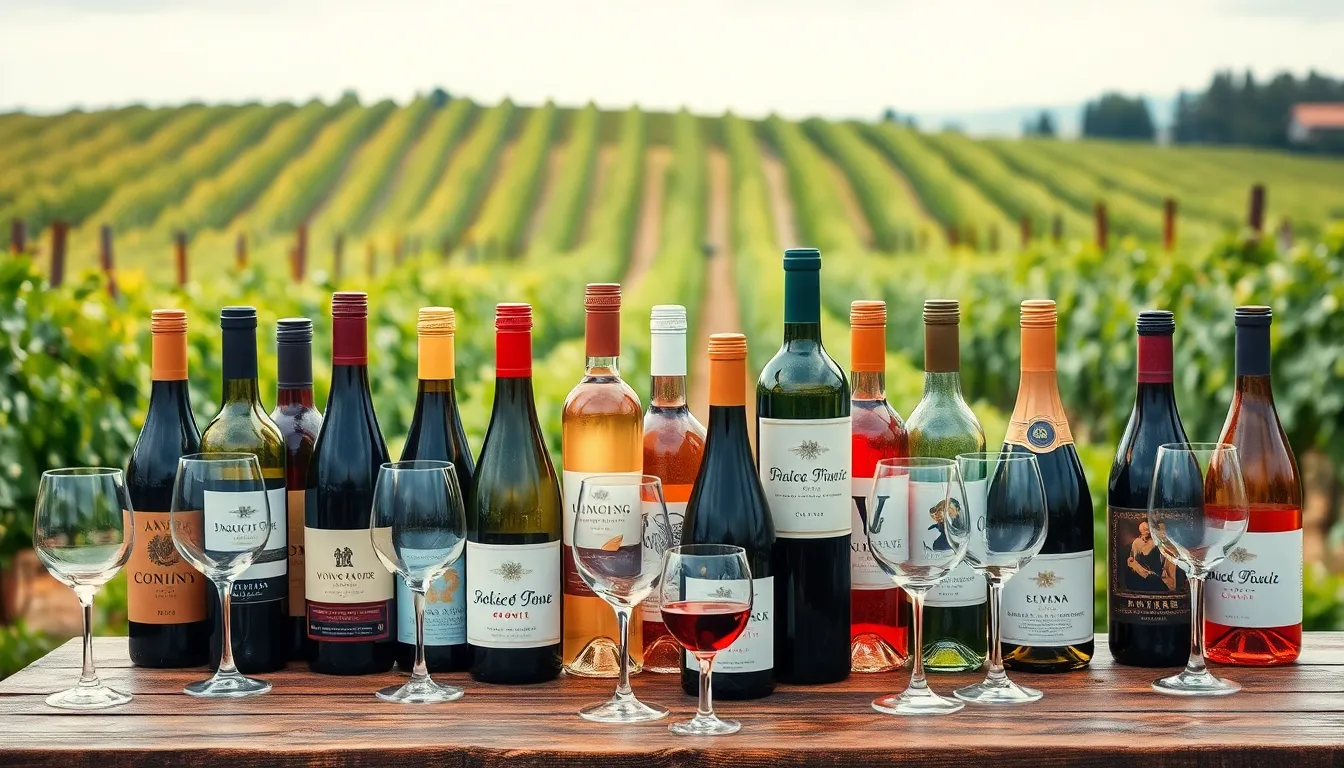Table of Contents
ToggleWine lovers, rejoice! Navigating the vast sea of wine options can feel like trying to find a needle in a vineyard. With countless bottles beckoning from shelves, how does one choose the perfect pour? That’s where wine product reviews come in, serving as your trusty compass in the world of merlot and chardonnay.
Overview of Wine Product Reviews
Wine product reviews serve as valuable tools for consumers navigating the extensive wine market. They provide insights into flavor profiles, aromas, and pricing, helping buyers make informed choices. Reliable reviews help demystify various wine types, such as reds, whites, and rosés, showcasing their unique characteristics.
A critical element in wine reviews is the scoring system. Many reviewers use numerical ratings to simplify comparisons among wines. These scores often reflect aspects like taste, balance, and finish. Descriptive notes accompany scores, offering details that enhance understanding of the wine’s qualities.
Furthermore, wine product reviews frequently contain information about the producer and region. Knowing where a wine comes from can influence its flavor and expected quality. Geographic characteristics, such as climate and soil, contribute to a wine’s specific taste profile and overall reputation.
Reviews may also consider pairing recommendations. Many reviewers suggest ideal food combinations to enhance the tasting experience. A well-paired wine can elevate a meal, making recommendations an essential part of the wine review process.
Additionally, readers can find consumer feedback in reviews. Anecdotal experiences provide practical insights regarding a wine’s enjoyment level. Collectively, this information can clarify expectations and guide purchasing decisions.
By focusing on quality and transparency, wine product reviews bridge the gap between wine producers and consumers. In doing so, they simplify the decision-making process and promote a greater appreciation for wine.
Types of Wines Reviewed

Different types of wines receive critical evaluations, helping consumers determine their preferences. Each category showcases unique characteristics that appeal to diverse palates.
Red Wines
Red wines feature robust flavors, making them popular among enthusiasts. Notable varietals include Cabernet Sauvignon, Merlot, and Pinot Noir, each offering distinct taste profiles. Reviews often highlight tannin levels, acidity, and finish, providing insights into food pairings. For example, Cabernet Sauvignon pairs well with red meats, while Pinot Noir complements poultry. Preference for red wines often stems from their complexity and depth.
White Wines
White wines provide a refreshing contrast to red options. Varietals such as Chardonnay, Sauvignon Blanc, and Riesling stand out due to their unique aromas and flavors. Reviews typically focus on citrus notes, sweetness, and acidity levels. Chardonnay, for instance, can range from buttery to crisp, depending on the production method. When enjoyed chilled, white wines enhance summertime gatherings and seafood dishes.
Rosé Wines
Rosé wines bridge the gap between red and white varieties. Typically made from red grapes with limited skin contact, they display vibrant colors and flavors. Noteworthy types include dry, sweet, and sparkling rosés. Reviews highlight the fruitiness and freshness, which makes them versatile for various occasions. Rosé often accompanies lighter fare like salads, seafood, or grilled chicken, making it a popular summer choice.
Sparkling Wines
Sparkling wines captivate with their effervescence and celebratory nature. Champagne, Prosecco, and Cava represent the primary styles within this category. Reviews examine the bubbly’s taste profile, level of sweetness, and acidity. Champagne, with its yeasty notes, is ideal for festive events, while Prosecco offers an approachable sweetness perfect for casual gatherings. Sparkling wines enhance any celebration, making them a favorite among consumers.
Factors to Consider in Wine Product Reviews
When evaluating wine product reviews, several key factors emerge as essential components. Understanding these elements can significantly enhance the decision-making process for consumers.
Taste Profile
Taste profiles define the overall experience of a wine. Reviewers often emphasize intrinsic qualities like sweetness and acidity. Different wine varieties exhibit distinct flavor notes, which range from fruity and floral to earthy and spicy. Assessing balance, complexity, and finish provides additional insights. Specific wines, such as Cabernet Sauvignon, often showcase bold flavors that appeal to red wine enthusiasts. Similarly, lighter options, like Sauvignon Blanc, attract those who prefer refreshing sensations. Exploring these attributes helps buyers match wines with personal preferences.
Aroma and Bouquet
Aroma and bouquet significantly influence a wine’s appeal. Reviewers delve into scent characteristics that give clues about a wine’s quality and origin. Fruity aromas might indicate a fresh, vibrant wine, while earthy notes suggest more sophistication. Different grape varieties produce unique aromatic profiles, and unexpected scents can enhance the overall tasting experience. For instance, Pinot Noir often carries complex aromas that draw enthusiasts. Carefully examining these olfactory elements aids consumers in selecting wines that align with their expectations.
Price Point
Price points factor heavily into wine evaluations. Different tiers exist, from budget-friendly options to luxury selections. Assessing value becomes critical when comparing wines within a specific category. For instance, a high-quality bottle might provide an exceptional experience, justifying a higher price. Many reviewers suggest price as an important aspect, noting that good wine can be found across all ranges. Understanding the relationship between price and quality helps consumers make informed purchasing choices without overspending. Prioritizing quality within a desired budget enhances overall satisfaction with any selection.
Popular Wine Review Sources
Wine enthusiasts often rely on trusted review sources to guide their selections. Numerous platforms provide detailed insights, catering to diverse consumer needs.
Wine Enthusiast publishes expert reviews along with tasting notes for a wide range of wines. This site includes a scoring system that aids consumers in comparing options effectively.
Decanter stands out with comprehensive wine recommendations and in-depth articles. It offers annual awards highlighting the best wines in various categories, ensuring consumers stay informed about top choices.
Wine Spectator features detailed tasting notes and ratings from professional critics. Its extensive database helps users filter wines by type, region, or score, streamlining the selection process significantly.
James Suckling is renowned for its focus on premium wines, delivering professional ratings and tasting notes. This source emphasizes high-quality wines, making it ideal for those seeking exceptional options.
Vivino allows wine lovers to share reviews and ratings, democratizing the wine evaluation process. User contributions provide authentic feedback, reflecting a wide array of personal preferences.
CellarTracker enables wine enthusiasts to track their collections while offering a platform for reviews and ratings. This community-driven resource fosters discussions that enrich the wine-tasting experience.
Wine Rover caters to budget-conscious consumers by highlighting deals and value wines. It emphasizes affordability while maintaining quality assessments, appealing to those seeking good options at lower price points.
Each of these sources plays a crucial role in shaping consumers’ wine choices and enhancing appreciation for various styles and regions. Accessing multiple review sites broadens perspectives and supports informed purchasing decisions.
Navigating the world of wine can be overwhelming but utilizing wine product reviews simplifies the process. These reviews not only provide essential information about taste and quality but also empower consumers to make informed choices that suit their preferences. By understanding scoring systems and tasting notes, wine lovers can discover new favorites while appreciating the nuances of different varieties.
Accessing reputable review sources further enhances the experience, allowing enthusiasts to explore diverse styles and regions. With the right guidance, finding the perfect bottle becomes an enjoyable journey rather than a daunting task. Embracing wine reviews leads to greater satisfaction and a deeper appreciation of the rich world of wine.




